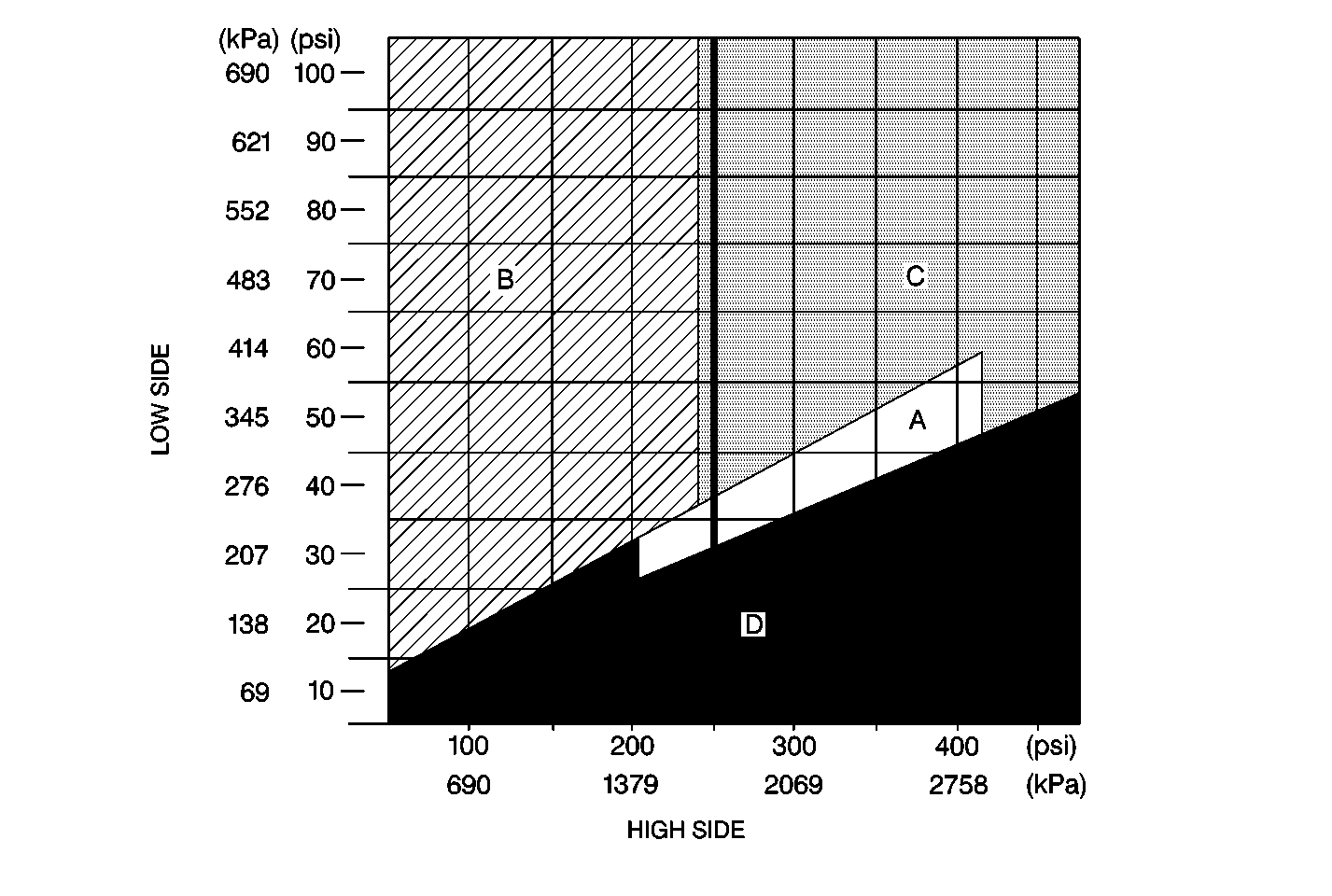Step
| Action
| Value(s)
| Yes
| No
|
1
| Were you sent here from the Cooling Insufficient, A/C System diagnostic
table?
| --
|
Go to Step 2
| Go to
Cooling Insufficient - Air Conditioning (A/C) System
|
2
|
- Start the engine.
- Turn the A/C ON.
- Feel the liquid line before the expansion (orifice) tube.
Is the liquid line cold before the orifice?
| --
|
Go to Step 3
|
Go to Step
8
|
3
| Feel along the surfaces of the following high side components
for a sudden drop in temperature (The high side components should feel warm/hot
from the compressor all the way to the orifice.)
| • | The compressor discharge hose |
| • | The liquid line between the condenser and the orifice |
Is there an abrupt drop in temperature noted along the surfaces of any
of the components listed?
| --
|
Go to Step
7
|
Go to Step
4
|
4
| Feel the liquid line at the orifice
location for extreme cold, possibly accompanied by heavy frost, then feel
along the liquid line after the orifice location for warm temperature.
Is the liquid line extremely cold at the orifice location and warm after
the orifice location?
| --
|
Go to Step 11
|
Go to Step 5
|
5
| Feel along the surfaces of the following low side components
for a sudden change in temperature.
| • | The liquid line between the orifice and the evaporator core |
| • | The vapor hose between the evaporator core and the accumulator |
| • | The compressor suction hose |
Is there an abrupt temperature change felt along the surfaces of any
of the components listed?
| --
|
Go to Step
7
|
Go to Step
6
|
6
| Feel along the surfaces of the
following Low and High side components to compare the overall temperatures
of the low and high sides.
| • | The liquid line between the orifice and the evaporator core |
| • | The vapor hose between the evaporator core and the accumulator |
| • | The compressor suction hose |
| • | The compressor discharge hose |
| • | The liquid line between the condenser and the orifice |
Are the overall temperatures of the low and high side components close
to the same (both only mildly warm) ?
| --
|
Go to Step
12
|
Go to Step
8
|
7
|
- Recover the refrigerant. Refer to
Refrigerant Recovery and Recharging
.
- Remove the restriction from the component, or replace the component
which produced an abrupt temperature drop.
Is the repair complete?
| --
|
Go to Step
15
| --
|
8
|
- Recover the refrigerant and evacuate the system. Refer to
Refrigerant Recovery and Recharging
- Record the wight of the charge which was removed.
Is the weight of the removed refrigerant charge equal to or above the
specified value?
| 0.57 kg (1.25 lb)
|
Go to Step
9
|
Go to Step
9
|
9
| Recharge the A/C system. Refer
to
Refrigerant Recovery and Recharging
Does the cooling performance improve?
| --
|
Go to Step 15
|
Go to Step 10
|
10
|
- Leak test the system. Refer to
Leak Testing
- Repair any leaks.
Is the repair complete ?
| --
|
Go to Step
15
| --
|
11
|
- The orifice tube is nearly plugged or damaged (opening too small).
- Replace the orifice tube. Refer to
Expansion (Orifice) Tube Replacement
- If the orifice tube was plugged or nearly plugged, note the type
of debris present.
- If metal flakes (chips) are present, replace the A/C compressor.
Refer to
Air Conditioning Compressor Replacement
- If a brown/black residue is present, replace the accumulator.
Refer to
Air Conditioning Accumulator Replacement
Is the repair complete?
| --
|
Go to Step
15
| --
|
12
|
- Recover the refrigerant. Refer to
Refrigerant Recovery and Recharging
- Disconnect the compressor hose from the compressor. Refer to
Compressor Hose Assembly Replacement
- Inspect for the presence of debris on the compressor suction port
screen.
Is there debris present on the compressor suction port screen?
| --
|
Go to Step 13
|
Go to Step 14
|
13
|
- Remove the debris from the suction port screen.
- Inspect the orifice for damage. Refer to
Expansion (Orifice) Tube Replacement
- If the orifice does not show any signs of damage replace the accumulator.
Refer to
Air Conditioning Accumulator Replacement
Is the repair complete?
| --
|
Go to Step
14
| --
|
14
|
- Recharge the A/C system. Refer to
Refrigerant Recovery and Recharging
- Leak test the refrigerant system. Refer to
Leak Testing
Are the repairs completed?
| --
|
Go to Step
15
| --
|
15
| Take readings of the low and high side pressures as well
as the dash outlet air temperature after repairs are performed.
Compare the pressures and outlet temperature to those listed in the
A/C Performance Chart.
Are the readings within the specified ranges?
| --
|
Go to Step 16
| Go to
Cooling Insufficient - Air Conditioning (A/C) System
|
16
| Operate the system in order to verify the repair.
Did you correct the condition?
| --
| Go to
Step
17
| Go to
Symptoms
in HVAC System
- Manual
|
17
| Disconnect the J 39500-B
Is the operation complete?
| --
| System OK
| --
|

